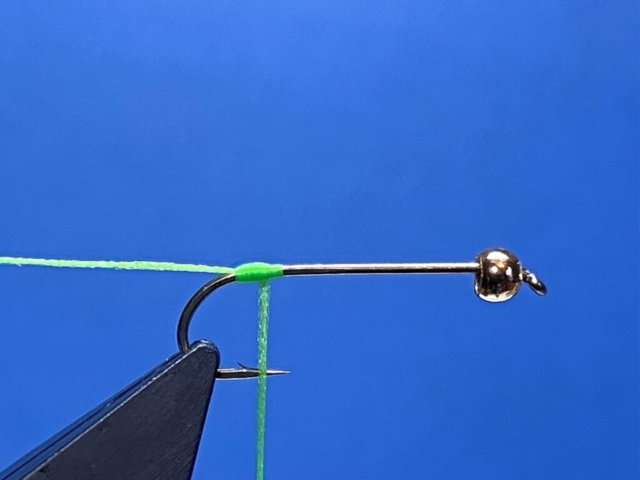A Fly to Tie & Try September by Les Lockey
Fly of the Month – September by Les Lockey
The Pearly Daddy – (Sid Knight)
Hook: Kamasan B800 lure hook, size 10.
Weight: 3.3 mm. Gold brass bead.
Tag: Glo Brite Floss, No 12, Fl. Green.
Thread: White UTC 70, and Veevus, 12/0, rusty dun.
Rib: Small UTC copper wire.
Underbody: White UTC 70 thread.
Overbody: Uni Pearl Mylar, size 12.
Thorax: Hare’s mask and fox squirrel fur, mixed.
Legs: 6 Cock pheasant centre tail fibres, knotted twice.
Wing: 2 Cree cock hackle point tips.
Hackle: Ginger or Cree cock.
TYING
Photo 1. Feed the bead on to the hook small hole first, and then secure the hook in the vice. For the tag, catch on the Glo Brite floss opposite the hook point and with the waste end over the hook bend, wind on the floss to the start of the hook bend and back to just before the starting position.
Photo 2. Pull the waste end of the floss over the top of the tag and secure it with the floss, then remove the waste floss.
Photo 3. Starting behind the bead, wind on the white thread in touching turns, remove the excess thread and continue the thread to the floss tag. Secure the floss with the thread and remove the floss. Apply a small drop of UV resin to the tag and cure it with a torch.
Photo 4. Leaving the waste ends the same length as the body, tie in the copper wire followed by the pearl Mylar. Bind down both waste ends with thread stopping at the thorax position. Continue to form a smooth underbody by winding the thread in touching turns down to the tag and back to the thorax.
Photo 5. Wind the pearl Mylar over the white underbody in slightly overlapping turns, tie it down at the thorax and remove the waste Mylar. Wind the copper wire in open turns over the body and tie it down at the thorax. Continue to bind down the wire to the bead and worry off the excess wire.
Photo 6. Catch on the rusty dun thread and remove the waste thread tag. Use the rusty dun thread to secure the white thread and then remove the white thread. Dub a little of the fur mix onto the new thread and wind it on to form the rear part of a small thorax.
Photo 7. Tie in 3 knotted pheasant tail fibres on either side of the shank with their tips extending well past the hook bend, then remove the waste fibre ends.
Photo 8. Align the tips of two Cree hackle points and using a couple of pinch and loops, tie them in on top of the shank with their tips extending just past the hook bend. Now separate the hackle points into a V shape and lock them in position with a couple of turns of thread tight up against the dubbing.
Photo 9. Remove the basal fluffy fibres from the bottom of the cock hackle and trim the stem to about 2mm. in length. Using well waxed thread, secure the hackle by the short stem. Apply a little more fur dubbing to the thread and starting at the base of the wings, wind on the second part of the thorax.
Photo 10. Wind the hackle in open turns over the dubbing, tie it down behind the bead, and remove the excess hackle. Apply a touch more fur dubbing to the thread and wind it on to cover the turns of thread securing the hackle.
Photo 11. Add some varnish to the thread, whip finish through it and cut off the thread, to complete the fly,
Tying tips
- Given the long list of materials for this fly, it might be thought of as a difficult fly to tie, but it is actually quite straightforward, so long as you leave enough space at the thorax for the legs, wings, and hackle.
- Pulling the waste end of the floss over the top of the tag stops the tag from slipping down around the hook bend and is something I do without thinking, but with the advent of UV resin, this is not strickly necessary.
- White flat thread makes a nice smooth underbody on which to wind the pearl Mylar, but a more muted thread colour such as rusty dun is best used for the rest of the fly.
- The thorax is dubbed in three parts, so it needs to be kept small and fine. The first part of the thorax helps to separate the legs and wings, while winding the hackle over the second part of the thorax helps to bed in the hackle, and the third part of the thorax is simply to cover the thread wraps used to tie down the hackle and gently force the hackle fibres rearward.
Fishing hints
- This is an excellent pattern from the vice of the late Sid Knight, who was probably best known for controversially trying to patent Trevor Housby’s dog nobbler. Thankfully this was refused, but the idea of having a weighted bead at the head to increase movement in the fly, was truly a lightbulb moment that has now been widely adopted throughout the world of fly tying and fly fishing.
- Despite never having seen a crane fly with a green butt and a white pearly body, this is a very effective pattern, even when crane flies are nowhere to be seen.
- It is usually fished on a floating line and long leader with a jerky retrieve to maximise movement in the legs. However, and perhaps rather surprisingly, the fly also works well when fished static, either under an indicator, or with a very, very slow figure of eight.














Recent Comments